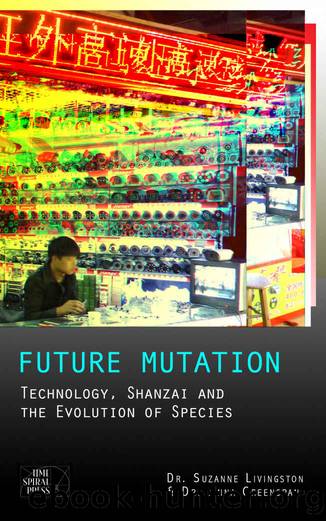Future Mutation: Technology, Shanzai and the Evolution of Species by Anna Greenspan

Author:Anna Greenspan
Language: eng
Format: epub
Publisher: Timespiral Press
Published: 2015-02-24T08:00:00+00:00
Rewind
According to the Book of Machines, the intimate relationship between humans and technology has left nothing untouched. âMan's very soul is due to the machinesâ writes Butler, âit is a machine-made thing: he thinks as he thinks, and feels as he feels, through the work that machines have wrought upon him, and their existence is quite as much a sine qua non for his, as his for theirs.â Emerging through this intense cross-fertilization is a single inseparable entity, that which philosophers Deleuze & Guattari call âa verterbro-machinate mammal.â
This emergent symbiosis undermines the comfortable, commonly held assumption that technology is just a tool, designed to fulfill our desires and serve our needs. The idea that machines âmust now and ever be man's inferiorsâ masks a more threatening, subterranean reality. The servant, contends The Book of the Machines, âglides by imperceptible approaches into the master⦠How many men at this hour are living in a state of bondage to the machines? How many spend their whole lives, from the cradle to the grave, in tending them by night and day? ... This is the art of the machines â they serve that they may rule.â [14]
In the fictional world of Erewhon this (still popular) sci-fi dystopia, in which humans function as mere component parts until, one day, a machinic takeover makes debris of us all, persuaded civilization to implement a rigorous technophobic program. All machines were abandoned, our cyborg future was snuffed out, and technological evolution was brought to an end.
Over 120 years later, at the turn of the second millennium, Bill Joy, one of the co-founders of Sun Microsystems, propelled Butlerâs argument forward into the twenty-first century. His famous and highly influential article Why the Future Doesnât Need Us makes an impassioned case for future management. Joy, echoing Butler, concentrates his concern on the reproductive capabilities of new technologies. âRobots, engineered organisms, and nanobots share a dangerous amplifying factor: They can self-replicate.â [14] With this capacity for reproduction, Joy warns, technology escapes our control. The article speculates on a series of ânightmarish scenariosâ in which the destructive dangers of GNR (genetics, nano tech and robotics) are âhugely amplified by the power of uncontrolled self-replicationâ¦.â In response to the terror of technological self-replication, Joy makes a plea for a âsteering of the futureâ such that technological evolution is tempered, certain pathways are avoided and knowledge and research is substantially restrained. âIf we could agree, as a species, what we wanted, where we were headed and why,â Joy writes, âthen we would make our future much less dangerous â we might understand what we can and should relinquish.â [15]
Why the Future Doesnât Need Us recognizes that far from any âspecies wide agreementâ on the management of new technologies, humans are strikingly blasé about the future as it arrives. âThe new Pandoraâs boxes of genetics, nanotechnology and robotics are almost open, yet we donât seem hardly to have noticedâ puzzles Joy. âWhy,â he asks with bemusement, âwerenât other people more concerned about these nightmarish
Download
This site does not store any files on its server. We only index and link to content provided by other sites. Please contact the content providers to delete copyright contents if any and email us, we'll remove relevant links or contents immediately.
Algorithms of the Intelligent Web by Haralambos Marmanis;Dmitry Babenko(16235)
Jquery UI in Action : Master the concepts Of Jquery UI: A Step By Step Approach by ANMOL GOYAL(9387)
Test-Driven Development with Java by Alan Mellor(7735)
Data Augmentation with Python by Duc Haba(7609)
Principles of Data Fabric by Sonia Mezzetta(7378)
Learn Blender Simulations the Right Way by Stephen Pearson(7294)
Microservices with Spring Boot 3 and Spring Cloud by Magnus Larsson(7137)
Hadoop in Practice by Alex Holmes(6587)
RPA Solution Architect's Handbook by Sachin Sahgal(6516)
The Infinite Retina by Robert Scoble Irena Cronin(6216)
Big Data Analysis with Python by Ivan Marin(5933)
Life 3.0: Being Human in the Age of Artificial Intelligence by Tegmark Max(5516)
Pretrain Vision and Large Language Models in Python by Emily Webber(4894)
Infrastructure as Code for Beginners by Russ McKendrick(4653)
Functional Programming in JavaScript by Mantyla Dan(4436)
WordPress Plugin Development Cookbook by Yannick Lefebvre(4382)
The Age of Surveillance Capitalism by Shoshana Zuboff(4245)
Embracing Microservices Design by Ovais Mehboob Ahmed Khan Nabil Siddiqui and Timothy Oleson(4148)
Applied Machine Learning for Healthcare and Life Sciences Using AWS by Ujjwal Ratan(4135)
